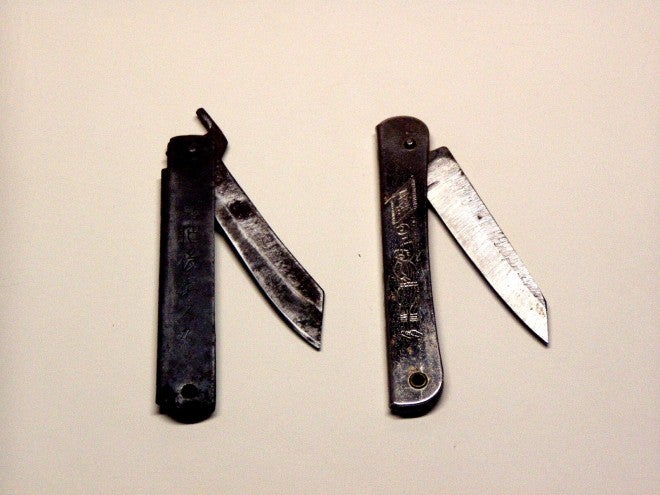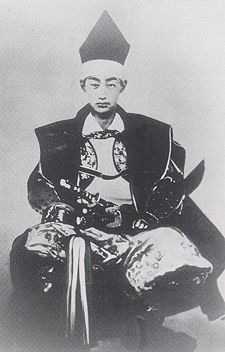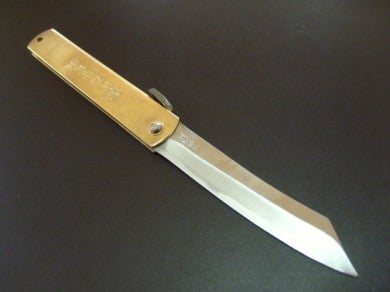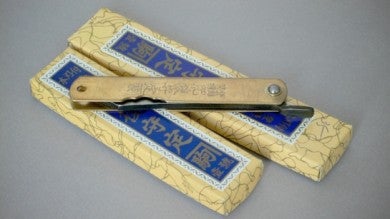EDC History: Higo no Kami
Ashley 05.06.14

Knife trends come and go, but some knives stand the test of time and remain popular from generation to generation. As evident by knives like the Swiss Army Knife or the Douk-Douk, sometimes less is more; durability and an iconic design can ensure a knife’s legacy.
One such knife is the Higo no Kami, a traditional Japanese pocket knife currently seeing a resurgence among everyday carry culture. For some, the Higo no Kami–also spelled as higonokami, or referred to as just a Higo–is an old stand-by. But for many, Higos are emerging from obscurity thanks to their unique design and history.

Origins of the Higo no Kami
The phrase “Higo no Kami” translates into “The Lord of Higo,” and it’s here that the rich history of this knife begins. Higo is the former name of what’s now known as the Kyushu province of Japan. Despite its grand name, the Higo no Kami is known for being a tool for the common folk (as the best knives seem to be).
Higo no Kami knives were made in 1896, and its creation is attributed to knifemakers Murakami and Shigeji Nagao. According to a research report published on BritishBlades.com, “The original knife … didn’t feature any device to lock the blade. The story says that [Murakami] first had the idea to add a lever to the blade, thus giving the knife the look it still has today and ensuring its commercial success.”
In the 1870s, a war between samurais and the “modern army of the emperor” resulted in samurais’ loss of power and status and, subsequently, their swords. Swordmakers turned instead to knifemaking to help recover lost profits from their flailing sword business. This took place in Miki, Japan, which is now known as the “historical birthplace of the higonokami,” according to the report. It wasn’t until 1907, when a knifemaker’s guild was established, that the name was trademarked.
After that, the popularity of the Higo no Kami soared. It became a must-have tool for many people of all ages, and the popularity continued throughout WWII. But a decline eventually began in the 1960s as the result of new knife laws. According to the BritishBlades report, the laws developed after a “mentally disturbed youngster murdered the head of the socialist party by slashing him in public with the same kind of sword that had been banned a century earlier in 1876.” Japan has had strict knife laws ever since.
As such, nostalgia has contributed to the consistency of Higo no Kami ownership, especially among those who owned Higos as children, and it appears that the once-beloved knife is once again finding a home in the pockets of knife collectors worldwide.

Appeal of the Higo no Kami
There are a few reasons Higo knives have been, and continue to be, popular: the design, the novelty, and the cost. Higo no Kami blades are typically less than 4 in., which makes for a light pocket folder. According to TheTruthAboutKnives and their series, “Know Your Knives,” Higo no Kami scales are “typically brass or soft metal, with friction lock or long tang to prevent accidental blade closure.”
Its inverted tanto blade shape is balanced with a handle of the same width, which gives the knife a simple, streamlined shape. When closed, the blade is entirely sheathed by the handle. The handle is stamped with kanji bearing the maker’s name and the blade material. The result is a traditional Japanese-style knife with a beautiful aesthetic that stands the test of time. Combined with brushed metal or raw wood EDC items, it’s easily modernized; paired with brass or gold items, it creates a more classic EDC. There is some power in its versatility.
Like the Douk-Douk, there is some novelty in its origins. The cultural significance makes it a refreshingly non-Western tool to possess. That it was beloved by former samurais is also a powerful reminder of the impact knives can have on the lives of their owners.
Although not every Higo knife on the web is the real deal (as explained below), most are available for under $100 on the internet. Amazon.com sells Higo no Kami knives starting at just $15, and that’s fairly consistent across the web.

EDCing a Higo
Higo no Kami knives make for a unique but reliable EDC folder, not unlike an Opinel. It’s interesting to note that while the Higo no Kami is the result of a long history of Japanese warrior culture, current Japanese knife laws prohibit carrying blades longer than 3 in. There are smaller Higo knives available to comply with these laws.
There are also variations of Higo knives, and it’s important for serious collectors to know the distinction. Many knives called Higo no Kami are considered replicas or knock-offs and are not actually legitimate. For some intending to EDC this knife, this is unimportant, as they still serve the same purpose and tend to still be well-made. Packaging can usually indicate if a Higo is the real-deal–traditional Higos come in a blue and gold box.
There is only one man left who manufactures the real Higo no Kami knives. That man is Motosuke Nagao, who is a descendant of blacksmiths in the Miki region. Nagao’s sucessor has yet to be named, and as he is aging, some fear that the trademarked Higo no Kami will be lost forever. Another knifemaker named Miyamoto Seisakusho is a former Higonokami guild member, and he also makes his own Higo no Kami-style knives referred to as Higonaifu (“Higo knife”). His knives have been praised for their quality, and although they are not the historical trademarked Higos, they are still well-respected among collectors.
The Higo no Kami is a knife that’s remained largely unchanged for the past 100 years. Although the future of the Higo no Kami is uncertain, its influence has been as strong and sharp as its iconic blade. The aesthetic will likely continue to be cherished in the future, and the history makes Higos a priceless addition to an everyday carry and knife collection.
To learn more about Higo no Kami knives, check out the full translated report at BritishBlades.com.